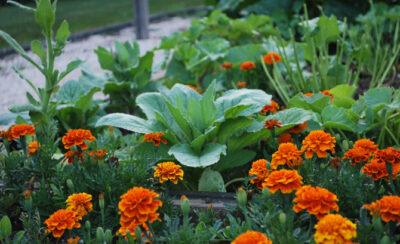
Image source: athomefc.com
It’s no secret that I love to spend time planning, planting, tending to and harvesting from my vegetable garden. My husband, on the other hand, would rather see colorful flowers adorning our backyard than something you would typically throw into a salad.
From what I’ve learned, it’s pretty common for one spouse to favor growing vegetables while the other is more interested in the visual appeal of vibrant blooms. Is there any hope of a mutual understanding? As a matter of fact … there is! You might be interested to know that there are some good reasons to include flowers amongst your tomatoes and zucchinis.
Companion Planting
The idea of companion planting has been around for a long time. The idea is to plant plants in close proximity to each other if they do not compete and if they can provide mutual benefits for each other. One of the most widely cited examples of companion planting is one that was commonly practiced by North American aboriginal peoples. Corn, squash and pole beans are commonly referred to as “the three sisters” because they can benefit each other when planted together.
Flowers can also be companion plants. Marigolds are great for helping to keep whiteflies away from your tomatoes; and borage, which produces a lovely blue flower, has been known to repel tomato hornworms and cabbage worms. Nasturtiums which come in a variety of reds, oranges, whites and golds deter aphids and make great companions to vegetables in the cabbage family. Have problems with Japanese beetles? Try deterring them with geraniums or petunias!
The Best Source For Garden Flower Seeds Is Right Here!
The following are eight flowers which you might want to consider including in your garden for companion planting:
- Baby’s breath – helps deter aphids.
- Californian poppy – helps deter aphids.
- Geraniums – companion to peppers, corn and grapes – deters leafhoppers and Japanese beetles.
- Lupin – companion to members of the cabbage family, lettuce and strawberries – fixes the nitrogen in the soil.
- Marigold – companion to tomatoes, peppers, and cucumbers as well as many others – deters pests such as whiteflies.
- Nasturtium – companion to beans, squash, tomatoes and fruit trees – attracts predatory insects which eat common pests.
- Petunia – companion to members of the squash family – deters leafhoppers and Japanese beetles.
- Zinnia – companion to peppers, tomatoes and beans – attracts hummingbirds which prey on whiteflies.
They Attract Pollinators
While it is possible to hand pollinate many garden crops, it’s so much easier to let the bees and butterflies do it for you. And with our bee population struggling, why not do something that will not only help them out, but also attract them to your garden and get your crops pollinated as well?
Story continues below video
Purple Echinacea (cone flowers) and bergamot (bee-balm) not only add a splash of color to your garden, but they also play an important role in attracting these beneficial insects into your garden.
They Improve the Soil
Drive by a large agricultural farm, and you’ll see huge fields of corn, soybeans or whatever. Take a walk through a wooded area, and you’ll find many different types of plants co-existing together. This plant diversity is important to the insects and animals that inhabit the area, but did you know it was even good for the soil?
New Natural Fertilizer Doubles Garden Production!
Plants draw their nutrients from the soil. And bacteria, mites and other organisms get the nutrients that they need from the roots of plants. These micro-organisms then transfer nutrients back into the soil. The more diverse the plant life, the better the soil will be and it will be able to support more nutrient-dense crops.
Some Flowers are Edible
If you insist on planting only edibles in your garden, you’ll be happy to know that there are many flowers that you can eat. Adding a few brightly colored pansies or nasturtiums to a salad is a fantastic way to impress family and friends at your next summer barbeque.
Borage produces a stunning blue flower that tastes like cucumber. Try freezing these flowers into some ice cubes and adding to a summer cocktail!
Some edible flowers (and their flavor profile) include:
- Allium – garlic or onion flavor.
- Angelica – anise or licorice flavor.
- Borage – tastes similar to cucumber.
- Carnations – sweet and perfumed.
- Chrysanthemums – mildly bitter and peppery.
- Fuchsia – tangy flavor.
- Gladiolus – bland on their own but can be stuffed.
- Impatiens – bland but add lovely color to dishes.
- Jasmine – fragrant and floral tasting.
- Nasturtiums — sweet and peppery.
- Pansies – bland in flavor but add a lover pop of color to salads, desserts and drinks.
- Roses – perfumed flavor – the darker the color, the stronger the flavor.
- Violets – sweet in flavor.
Note that while many flowers are edible, you generally should not eat ones that you have purchased at a garden center, as these may have harmful sprays added to them.
Finally, one very simple (and good!) reason to add flowers to your vegetable garden is for their beauty alone. If having flowers amongst your vegetables helps you to appreciate your garden more or entices you to spend more time in it, then that is a wonderful goal in itself!
What flowers do you prefer to plant in your garden? Share your advice in the section below:
What’s The Biggest Mistake Gardeners Will Make This Year? Find Out Here.